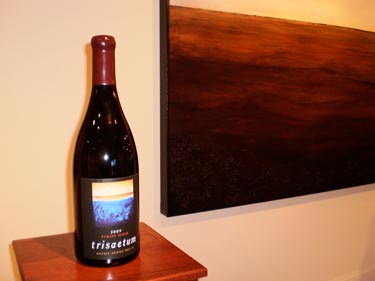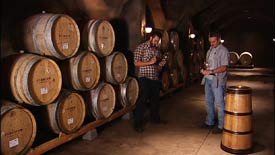Newberg, Oregon. For James Frey, the art of winemaking is quite literally another art form that he endeavors to perfect.
Both in his paintings that line the walls of trisaetum Winery, Vineyards, and Gallery and the wines that he and co-winemaker Greg McClellan blend together into a finished style, his wines are an extension of the artist’s palette. They are as finely tuned to his own sensibility of taste, as to the finished canvasses upon which the final dollops of color have been added. The brush laid down, the painting now completed— so too, the final blends chosen, accented toward expressing the full potential of a particular vintage.
Mr. Frey explains the duality of being a painter and a winemaker; in essence, of an artist who works in two different mediums that draws upon an overlapping sense of aesthetic:

Photo courtesy of Lynn Torrance Redlin
“When I’m approaching a painting, I don’t want to paint just in blue. In fact, if I’m using blue, I don’t want just one shade of blue, I want 8 different shades of blue, I want to paint with reds and yellows, greens and oranges.
The same thing happens when we put together a bottle of wine. We don’t want a single note, a single color let’s say, and so the palette that we use as an artist effects the palette that I taste my wine with. And so, I’m looking for lots of different variety in the barrels of wine that I have, so that when I’m blending wine, it’s not just one note.”
Each barrel has its own special components for a variety of reasons. In addition to the types of fermentation tanks that are used (wood and stainless steel), there are different clones of pinot noir, and different soils within the Willamette Valley region that result in a variety of different flavor characteristics for the pinot noir grapes. At trisateum, the blending process is the final stage of winemaking after the barrels have aged for a period of 12 to 18 months, and the wine is then ready to be bottled. From the 120 barrels of pinot noir for a given year, a particular style will be blended together, as Mr. Frey further explains:
“There might be another wine we are trying to make that year of pinot noir that would have dark fruit, that would have more structure, maybe a little more tannin, maybe ages a little bit longer— a wine that you maybe want to drink after 2 or 3 years. Those kind of barrels we’ll tag, and those we’ll try to blend into that particular type of wine. So the blending process is really going through the entirety of our cave, segmenting barrels into particular styles with particular characteristics and then trying different combinations until we get the 8 different pinot noir’s that we think are perfect for the vintage.”
Editor’s note: this post has been re-edited for clarity and conciseness.
Visit Yamhill Valley Wines for their “Wines of the Valley” series that features the history, quality and diversity of the Yamhill Valley’s flourishing wine industry. For the introductory video, along with the video series list, check out the first post on CUPS: The Yamhill Valley Wine Region of Oregon
Most of the videos featured on Cooking Up a Story were produced, filmed, and edited by Rebecca Gerendasy. Fred Gerendasy contributed as a writer to many of the posts and occasionally as the interviewer. Visit Rebecca Gerendasy Clay – Art and Fred Gerendasy Photography to see their current work.

